 |
The Saint of the Day
St. Bruno, October 6
Prof. Plinio Corrêa de Oliveira
Biographical selection:
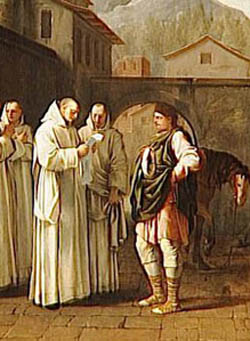
Above, St. Bruno receives a messenger from Rome asking him to assist the Holy See
Below, St. Bruno pays homage to his former student, Pope Urban II
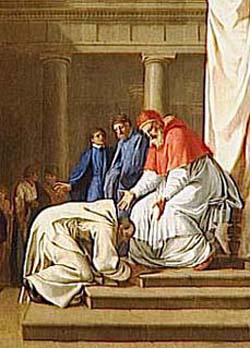
Paintings by Eustache Le Sueur |
St. Bruno was born in Cologne, Germany around the year 1030. While still quite young, he went to Reims, France, whose schools were famous. His keen intelligence and application to study earned the admiration of the Archbishop of Reims, who invited him to be director of all the educational establishments of the Diocese.
The new master had numerous pious disciples, among them Eudes de Châtillon, the future Pope Urban II, preacher of the First Crusade. St. Bruno was wise and erudite, learned in Greek and Hebrew. He also had a natural gift for poetry and an amiable disposition. These characteristics explain the enthusiasm roused by his comments on Sacred Scriptures.
His orthodox teaching and the fame of his sanctity raised up many enemies against him. The Archbishop of Reims was engaged in simony, giving ecclesiastical privileges in exchange for money. When St. Bruno realized this, he denounced him to superior ecclesiastical authorities, and the unworthy Prelate was called to answer for his misdeeds. The Prelate’s reply was to persecute St. Bruno. Bruno lost his post, his titles, and his goods, and was exiled.
Only in 1080, after a definitive sentence against the persecutor came from Rome, could St. Bruno return. He was invited to be the Archbishop of Reims, as successor to the bad Prelate. Bruno, however, refused. Having come to understand the vanity of worldly things, he had made a vow to abandon the world and serve God in solitude.
In 1084, he, along with six companions, went to the Dauphiné, a province of France, and asked his former student, St. Hugo de Châteauneuf, Bishop of Grenoble, to provide them an isolated place to live. St. Hugo conducted and installed them in a wild spot on the Alps called Chartreuse, amidst precipitous rocks and almost inaccessible. Bruno soon initiated the building of a hermitage, which was finished one year later and its chapel consecrated. The style of this small edifice served as model for all the Carthusians in France and other countries.
The tranquil life of prayer and retirement of St. Bruno was short-lived. In 1090, a letter from Pope Urban II called him to Rome to assist the Apostolic See. After passing some months in the papal court, Bruno again managed to retire to a hermitage in Southern Italy, where Count Robert of Calabria had given him a large tract of land. It was there that in 1101 he serenely slept in the Lord.
Comments of Prof. Plinio:
The life of St. Bruno raises several important considerations.

Above, the present day motherhouse, La Grande Chartreuse, on the site of St. Bruno's first monastery
Below, The austere and grandiose lines of the cloister reflect the Carthusian spirit
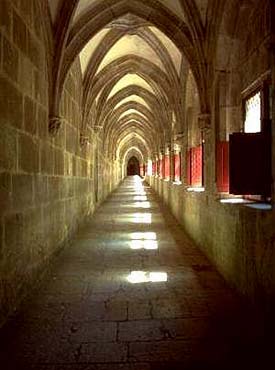
|
First, through it we can perceive one of the spiritual origins of the Crusades. For, the first Crusade was preached by Pope Urban II, whose spiritual formation was given by St. Bruno, a lover of solitude. Therefore, at the base of that movement of great activity, we find the contemplative spirit. The Crusades are one of the greatest glories of the History of the Church. They awaken the enthusiasm of true Catholics, and the indignation of all the modernists and progressivists who infest the Church today. John XXIII, for instance, used to say that he hated them so much that he could not endure hearing the name. It is agreeable to consider that the spirit of silence and recollection can produce an action so vigorous and strong as the First Crusade.
Second, when St. Bruno was persecuted by the unworthy Archbishop, he gave the example of what we should do today when one is under a bad ecclesiastical authority. One should defend orthodoxy, as he did. The Archbishop was a simoniac, a man of bad principles. St. Bruno resisted him, denounced him, and stood up for the truth. He did not disobey in matters where the Prelate still had a legitimate authority, but he did not make any concession in orthodoxy. In such a manner, our duty is to obey the Catholic Church, the traditional doctrine of the Popes. And if someone in the name of the Church teaches false principles, we must say that he is wrong. It is what St. Bruno did, and for that he was persecuted.
Third, in exile and solitude, far from the opulence of the world and ecclesiastical splendor, the idea of abandoning all those things and dedicating himself to God was born in his spirit. In this frame of mind, he was invited to return to Reims as its new Archbishop.
He had a great reputation for sanctity and learning, and was a well-liked speaker, so he had what was needed to be an excellent Archbishop.
The position of the Archbishop of Reims was one of the most important in Europe at that time. It cannot compare with the position of the Archbishop of Reims today, when he is only one archbishop among others. But in those times, when the King of France was crowned in Reims, the Archbishop of Reims had the title of Duke and Pair of France and the Cathedral of Reims was one of the most frequented in Christendom, a monument attracting the attention of the whole Catholic world for its religious art. That is to say, the Archbishop of Reims was an international figure. St. Bruno was invited to this position.
You can imagine the consolation this invitation represented. He had been severely persecuted by the bad Archbishop of Reims, who had just been deposed, and now he could be his successor. It would be a brilliant victory for him. To assume such a position would also permit an enormous irradiation of his virtue and talent. He could easily convince himself that he would be more useful to the Church as Archbishop of Reims than as a hermit in a forest or desert.
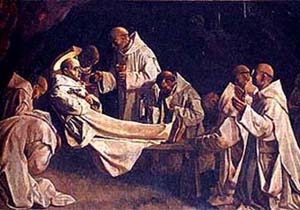
Above, the death of St. Bruno at the Monastery of Calabria, whose ruins you can still visit today, below
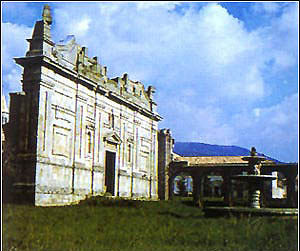
|
Invited to that position, St. Bruno refused. He turned away from this high position to realize his desire, which was to have a contemplative life in entire solitude, meditating upon God, Our Lord Jesus Christ. So, he chose to abandon everything, and be unknown to all in order to seek exclusively for God.
Fourth, he built a hermitage, a small edifice including a chapel. That building became famous all over Christendom because of the virtue of the men who lived there. This is something that the modernists and progressivists don’t understand. They understand the apostolate exclusively as an action whereby an apostle runs after others to convert them. It is a legitimate form of apostolate, but it is not the only one. There is another type whereby the apostle runs away from others, and, doing so, attracts them to his own way of life. This was the form of apostolate that St. Bruno practiced and made famous with his hermitage.
Fifth, he wanted to live in isolation and solitude, but suddenly he received a letter from his former student, Pope Urban II, inviting him to assist the Holy See. He went, and accomplished what he was asked to do. As soon as his task was finished, he retired to a solitary place in Southern Italy, lived there for more than ten years, and tranquilly died.
The result of this life is that he founded a religious order that is a model of solitude. The Carthusians live in greater solitude than even the Trappists. The latter live in community, in a monastery, but the former live alone, isolated in small hermitages or private cells, and meet together only for praying the Holy Office and meals. This solitude impressed the world and raised its admiration. It became one of the glories of the Catholic Church and spread throughout the whole world.
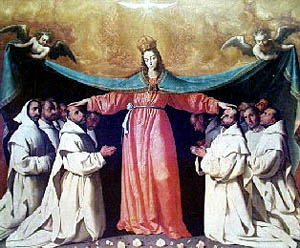
The Carthusian order under the protective mantle of Our Lady
|
For what should we ask St. Bruno on his feast day?
* The love of recollection and humility, to be without pretensions, to love to live unknown and ignored by others.
* Even if we are obliged to live among others, to not be concerned about what they are thinking about us.
* To love spiritual solitude, turned exclusively to Our Lord Jesus Christ, Our Lady, and the Holy Catholic Church.
* To be faithful to grace and the orthodoxy of true Catholic doctrine, and to strive for the salvation of our souls so that we might go to Heaven and see God face to face.
We also should ask St. Bruno to watch over the desolate situation of the Catholic Church, and help to restore her, and in her, the order that he founded, the Carthusians.


  | | Prof. Plinio Corrêa de Oliveira | |
The Saint of the Day features highlights from the lives of saints based on comments made by the late Prof. Plinio Corrêa de Oliveira. Following the example of St. John Bosco who used to make similar talks for the boys of his College, each evening it was Prof. Plinio’s custom to make a short commentary on the lives of the next day’s saint in a meeting for youth in order to encourage them in the practice of virtue and love for the Catholic Church. TIA thought that its readers could profit from these valuable commentaries.
The texts of both the biographical data and the comments come from personal notes taken by Atila S. Guimarães from 1964 to 1995. Given the fact that the source is a personal notebook, it is possible that at times the biographic notes transcribed here will not rigorously follow the original text read by Prof. Plinio. The commentaries have also been adapted and translated for TIA’s site.
|
Saint of the
Day | Home | Books
| CDs | Search
| Contact Us | Donate

© 2002- Tradition in Action, Inc. All Rights Reserved
|
 |

|